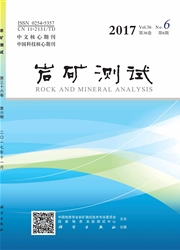

 中文摘要:
中文摘要:
煤矸石是我国堆存量最大的工业固体废物,本文应用电感耦合等离子体发射光谱法、逐级化学提取法和相关性分析研究了淮北临涣矿区低硫煤矸石中10种微量元素的含量及赋存状态,并运用风险评价指数法评价其环境效应。结果表明,低硫煤矸石中Ba、Co、Cr、Mn、Ni、Pb、V含量均高于淮北煤和中国煤均值,Mn、V的富集系数大于1,有一定迁移风险。微量元素主要以残渣态和铁锰氧化物结合态存在,两者质量分数之和为68.87%~92.93%,其中Cd、Co、Cr、Cu、Ni、Pb、zn赋存于硫化物矿物中,V赋存于黏土矿物中,Mn赋存于碳酸盐矿物和硫化物矿物中.10种微量元素对环境的危害性大小为:Mn〉Zn〉Ni〉Pb〉Cd〉Cu〉Ba〉V〉Cr〉Cc),表明低硫煤矸石堆存过程中活性态Mn对生态环境造成危害的可能性最大,由Mn可能引起的煤矸石山周边地区土壤及水体污染应当重视.
 英文摘要:
英文摘要:
Coal gangue is the largest industrial solid waste in China. Trace elements in low-sulfur coal gangue samples from the Linhuan coal mining area in the Huaibei coalfield were measured by Inductively Coupled Plasma- Optical Emission Spectrometry (ICP-OES). Sequential extraction procedure and correlation analysis were employed to analyze the occurrence of trace elements in coal gangue. Meanwhile, the environmental effect of trace elements was studied by Risk Assessment Code (RAC). The results showed that trace elements (Ba, Co, Cr, Mn, Ni, Pb and V) were enriched in coal gangue compared with Huaibei coals and Chinese coals, in which the enrichment factors of Mn and V were greater than 1, indicating a certain risk of migration. Trace elements predominantly occur in residual and Fe-Mn oxide bound, the total quality fractions of which range from 68.87% to 92.93%. Cd, Co, Cu, Ni, Pb and Zn are hosted in sulfide minerals, V is hosted in clay minerals, and Mn mainly in carbonate minerals. The environmental hazard of trace elements was in order of Mn 〉 Zn 〉 Ni 〉 Pb 〉 Cd 〉 Cu 〉 Ba 〉 V 〉 Cr 〉 Co, indicating that active Mn most likely pollutes the environment during the outdoor storage of coal gangue and the soil and water pollution induced by Mn should be of concern.
 同期刊论文项目
同期刊论文项目
 同项目期刊论文
同项目期刊论文
 期刊信息
期刊信息
